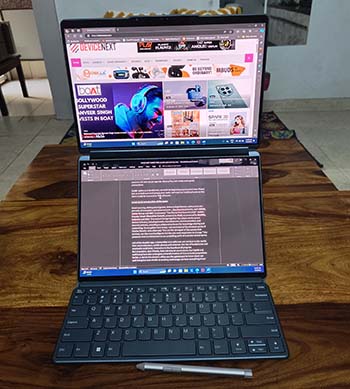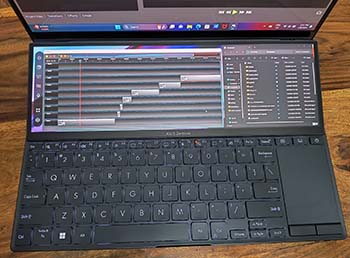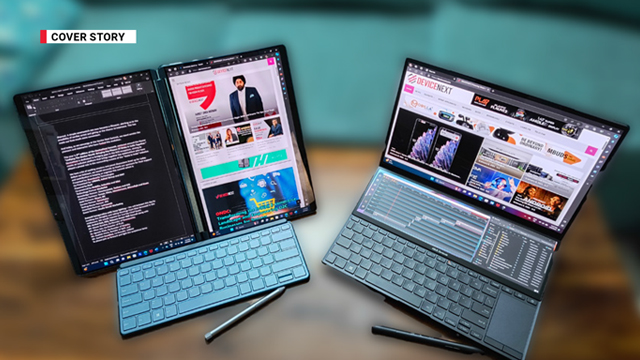Laptops have been our companions through work, leisure, and every nuance in between. Over the years, we’ve witnessed remarkable innovations in chipsets, storage, graphics cards, and display technology. Despite these advancements, the overall form factor of laptops has remained consistent, with the familiar clamshell design hosting a display on one side and a keyboard on the other.
While at work, you would have used dual monitors to make your work efficient and productive by connecting a secondary display to your laptop or desktop. Be it video calls along with presentations, editing films and images, working on a large spreadsheet, or even when playing an immersive video game, the extra screen space is always helpful. What if you could get a second-screen experience within the laptop form factor? ASUS catapulted dual-screen laptops into the mainstream by disrupting the traditional clamshell design with its Zenbook DUO range. ASUS’s innovative approach introduced a secondary screen cleverly integrated alongside the keypad, challenging the very essence of traditional laptop design. Lenovo took the challenge a step further, presenting the Yoga Book 9i – a true dual-screen laptop boasting full-sized displays on either side of the clamshell. The unmistakable paradigm shift reached new heights at this year’s CES, where both ASUS and Lenovo showcased dual-screen laptops with expansive full-size screens.
Dual-screen laptops usher in a new era of incredible multitasking capabilities, particularly beneficial for professionals in architecture, design, and UI programming, offering valuable extended screen real estate. However, like any innovation, the introduction of dual-screen laptops requires users to adapt to the changing landscape of laptop design. Though the idea of a higher price and a slight increase in weight might discourage some, the benefits of increased productivity and versatile usage make the transition unquestionably worthwhile.
Whether one opts for the simplicity of a single screen or embraces the adaptability of twin screens, the undeniable truth remains – dual-screen laptops are not just a step forward; they signify a leap into the future of computing.
Lenovo Yoga Book 9i
 The Yoga Book 9i stands out with its eye-catching full-size dual-screen design, evoking envious glances in any setting. What sets it apart is its flexibility in usage. Whether in side-by-side screens for unique portrait modes, a versatile folio stand transforming it into a horizontally stacked dual-monitor desktop setup, or in the tablet or tent form, the Yoga Book 9i proves its versatility in various scenarios. Lenovo astutely includes a range of accessories – a Bluetooth keyboard, folio stand, and stylus – providing users with the flexibility to configure the device to match their needs. Despite the dual-screen setup, the laptop maintains a sleek profile, appealing to those prioritizing portability.
The Yoga Book 9i stands out with its eye-catching full-size dual-screen design, evoking envious glances in any setting. What sets it apart is its flexibility in usage. Whether in side-by-side screens for unique portrait modes, a versatile folio stand transforming it into a horizontally stacked dual-monitor desktop setup, or in the tablet or tent form, the Yoga Book 9i proves its versatility in various scenarios. Lenovo astutely includes a range of accessories – a Bluetooth keyboard, folio stand, and stylus – providing users with the flexibility to configure the device to match their needs. Despite the dual-screen setup, the laptop maintains a sleek profile, appealing to those prioritizing portability.
Crafted with a Tidal Teal-colored all-aluminum chassis, it exudes premium quality. The dual symmetrical 13-inch OLED touch displays, fused onto Corning Gorilla Glass 3, resist scratches and elevate the visual experience. Under the hood, an Intel Core i7-1355U CPU, 16 GB LPRRD5 RAM, and a 512 GB SSD ensure commendable performance. Although the Yoga Book 9i comes with an integrated Intel Iris Xe GPU, not suited for immersive gaming but useful for short video edits in content creation and social media. In the real world, most users won’t notice the difference when handling general productivity and lighter creative tasks. The battery, too, lasts a day of work.
 The magic happens when you embrace the touchscreen-based keyboard, providing an excellent and natural typing experience, complemented by a responsive touchpad. The included Bluetooth keyboard magnetically attaches to the bottom screen, instantly transforming it into a traditional laptop setup.
The magic happens when you embrace the touchscreen-based keyboard, providing an excellent and natural typing experience, complemented by a responsive touchpad. The included Bluetooth keyboard magnetically attaches to the bottom screen, instantly transforming it into a traditional laptop setup.
With three Thunderbolt 4 USB-C ports, a 360-degree Bowers & Wilkins soundbar, and a decent 5MP webcam, the Yoga Book 9i covers connectivity and multimedia needs. However, the absence of a 3.5mm headphone jack indicates Lenovo’s preference for users to connect Bluetooth audio devices.
 Despite a slight learning curve for the dual-screen setup and the customized Windows 11 interface, the Yoga Book 9i’s adaptability becomes evident. For those willing to adapt, the benefits are substantial. Catering to both productivity and entertainment, it is an excellent choice for professionals and creatives. This premium device comes at a premium price – INR 225,190.
Despite a slight learning curve for the dual-screen setup and the customized Windows 11 interface, the Yoga Book 9i’s adaptability becomes evident. For those willing to adapt, the benefits are substantial. Catering to both productivity and entertainment, it is an excellent choice for professionals and creatives. This premium device comes at a premium price – INR 225,190.
In conclusion, the Lenovo Yoga Book 9i is a bold leap into the future of computing, balancing style, functionality, and adaptability. It caters to individuals willing to invest not just in a device but in a transformative experience.
ASUS Zenbook Pro DUO 14 OLED
 The ASUS Zenbook Pro 14 Duo OLED stands out as an exceptional choice for business users aiming to enhance productivity and versatility without compromising portability. The laptop’s unique dual-screen layout redefines the conventional laptop experience, seamlessly integrating a stunning 14.5-inch OLED main display with a smaller 12.7-inch 2.8K 120Hz ScreenPad Plus. This additional screen not only offers extended real estate but also serves as a multifunctional workspace, complete with touchpad functionality and customizable quick buttons.
The ASUS Zenbook Pro 14 Duo OLED stands out as an exceptional choice for business users aiming to enhance productivity and versatility without compromising portability. The laptop’s unique dual-screen layout redefines the conventional laptop experience, seamlessly integrating a stunning 14.5-inch OLED main display with a smaller 12.7-inch 2.8K 120Hz ScreenPad Plus. This additional screen not only offers extended real estate but also serves as a multifunctional workspace, complete with touchpad functionality and customizable quick buttons.
Crafted with ergonomic design principles in mind, the Zenbook Pro 14 Duo OLED features a secondary screen raised at a 12-degree angle for comfortable viewing and enhanced usability. Despite the unconventional layout, the backlit keyboard remains comfortable for typing, albeit with a distinct touchpad placement to the right. ASUS has ingeniously optimized the secondary screen’s utility with a dedicated taskbar, providing quick access to various features and functions.
 Powering the Zenbook Pro 14 Duo OLED is a formidable 12th Gen Intel Core i9 processor, coupled with 16GB of RAM and a capacious 1TB SSD. This robust configuration, complemented by a creator-grade NVIDIA GeForce RTX 4050 GPU, ensures seamless performance for both professional content creation and gaming tasks. The laptop’s powerhouse setup, cooled by ASUS IceCool Plus technology, enhances its capability in handling graphics-intensive activities such as 3D rendering and video editing. The device impressively marries a sleek profile, featuring dual symmetrical 13-inch OLED touch displays, with potent internals that contribute to an exceptional user experience. In terms of connectivity, the Zenbook Pro 14 Duo OLED offers ports for Thunderbolt, USB 3.2 Gen 2, HDMI 2.1, and more, catering to diverse connectivity needs.
Powering the Zenbook Pro 14 Duo OLED is a formidable 12th Gen Intel Core i9 processor, coupled with 16GB of RAM and a capacious 1TB SSD. This robust configuration, complemented by a creator-grade NVIDIA GeForce RTX 4050 GPU, ensures seamless performance for both professional content creation and gaming tasks. The laptop’s powerhouse setup, cooled by ASUS IceCool Plus technology, enhances its capability in handling graphics-intensive activities such as 3D rendering and video editing. The device impressively marries a sleek profile, featuring dual symmetrical 13-inch OLED touch displays, with potent internals that contribute to an exceptional user experience. In terms of connectivity, the Zenbook Pro 14 Duo OLED offers ports for Thunderbolt, USB 3.2 Gen 2, HDMI 2.1, and more, catering to diverse connectivity needs.
 Despite its formidable performance, the Zenbook Pro 14 Duo OLED falls short in the battery department, delivering around 4 hours of regular usage due to its dual OLED displays. However, its innovative design, robust performance, and comprehensive feature set make it a compelling choice for creatives and professionals alike.
Despite its formidable performance, the Zenbook Pro 14 Duo OLED falls short in the battery department, delivering around 4 hours of regular usage due to its dual OLED displays. However, its innovative design, robust performance, and comprehensive feature set make it a compelling choice for creatives and professionals alike.
With a starting price of INR 144,990, the Zenbook Pro 14 Duo OLED offers a unique proposition for users looking to elevate their workflow with dual-screen functionality and precise stylus input. While the laptop makes some sacrifices in terms of keyboard layout and size, it undeniably enhances the workflow of content creators. Despite being a niche laptop, its gorgeous dual displays, peppy performance, and unique features make it worth considering for those who can fully exploit its innovative dual-display setup.




